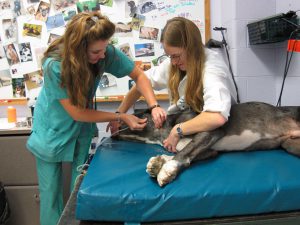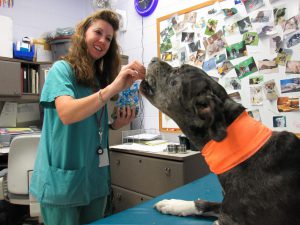The blood donation process for our furry friends is very similar to that of humans. Check out the steps below.

Dogs are brought up on the table and asked to lie on their side. A small area of fur is clipped and cleaned over the jugular vein .
Each unit of blood donated by a canine donor helps to save at least two canine lives.

The needle is inserted into the jugular vein and blood runs into the collection bag where it is weighed to be sure we collect the correct amount from each donor. Each unit donated is separated into packed red blood cells and plasma.
The packed red blood cells are used to treat anemias from chronic disease, blood loss during surgeries, traumas, and immune mediated and bone marrow issues.
The plasma is used to treat coagulopathies (failure of the blood to clot properly), low proteins, and some toxicities, such as rodenticide ingestion and snake venom.

When a unit is collected, the donor is allowed to sit up and a bandage is placed around the neck.
The MSU VMC usually has around 60 donor dogs and 4 donor cats.

The donor is rewarded with treats and/or play time and lots of praise.
Only 1 in 15 dogs is a universal donor, and there is no universal blood type in cats. Cats must be given their specific blood type.
